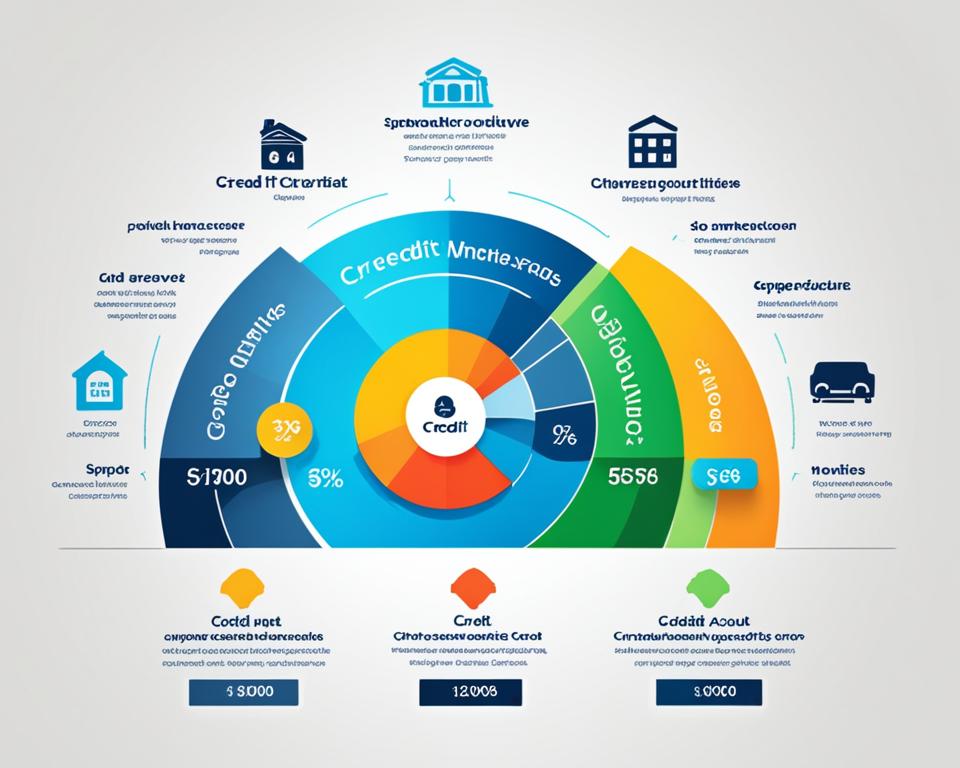When it comes to credit repair, one essential strategy to consider is diversifying your credit mix. A diverse credit mix can have a positive impact on your credit score and improve your overall creditworthiness. By having a variety of credit accounts, you can demonstrate your ability to manage different types of credit responsibly.
So how exactly does diversifying your credit mix help improve your credit score? It’s quite simple. Lenders and credit bureaus consider several factors when evaluating your creditworthiness, and one of them is your credit mix. Having different types of credit accounts, such as credit cards, loans, and mortgages, shows that you can handle various financial responsibilities.
Furthermore, a diverse credit mix also allows you to build a more well-rounded credit profile. Each type of credit account plays a unique role in establishing your credit history and demonstrating your financial stability. For example, revolving credit accounts like credit cards show your ability to manage short-term debts, while installment credit accounts like loans reflect your ability to handle long-term financial commitments.
Key Takeaways:
- Diversifying your credit mix is an important credit repair tip.
- Having different types of credit accounts can improve your credit score.
- Revolving credit (e.g., credit cards) and installment credit (e.g., loans) play different roles in credit diversification.
- Assessing your current credit mix is crucial for identifying areas of improvement.
- Strategies for diversifying your credit mix can help enhance your credit profile and boost your credit scores.
Why is Credit Diversification Important for Credit Repair?
When it comes to credit repair, diversifying your credit mix is a crucial strategy to consider. Having a variety of credit accounts can positively impact your credit score and overall creditworthiness. By understanding the importance of credit diversification and the types of credit accounts available, you can take proactive steps towards improving your credit profile.
So, why is credit diversification essential? By having different types of credit accounts, such as credit cards, loans, and mortgages, you demonstrate your ability to manage various financial responsibilities. Lenders and credit bureaus view this as a positive attribute, as it indicates that you can handle different types of credit obligations effectively.
When you have a well-rounded credit mix, it shows that you have experience with different credit products, which can increase your creditworthiness and improve your chances of getting approved for future loans or credit cards. The credit mix strategy plays a significant role in determining your credit score – one of the most critical factors lenders consider when assessing your creditworthiness.
It is important to note that simply having a few credit cards or loans is not enough. To optimize your credit mix strategy, you should consider having a diverse range of credit accounts, including revolving credit (such as credit cards), installment credit (such as loans), and mortgage credit.
Types of Credit Accounts:
| Types of Credit Accounts | Description |
|---|---|
| Revolving Credit | These are credit accounts with no fixed repayment term, and you can borrow up to a predetermined credit limit. Credit cards are an example of revolving credit. |
| Installment Credit | These credit accounts have a fixed repayment term and require you to make regular payments over a specified period. Examples include auto loans and personal loans. |
| Mortgage Credit | These are long-term loans used to purchase or refinance a home. Mortgage credit can have a significant impact on your credit mix strategy. |
By having a mix of these credit accounts, you demonstrate your ability to manage different types of credit, which can boost your creditworthiness and improve your overall credit profile.
Now that you understand why credit diversification is important for credit repair, let’s explore how to evaluate your current credit mix and develop strategies for diversifying it further.
Understanding the Different Types of Credit Accounts
In building a strong credit profile, it’s essential to understand the different types of credit accounts available to you. Each type plays a unique role in credit diversification and contributes to the overall health of your credit mix. By diversifying your credit accounts, you can establish a robust credit profile that showcases your ability to manage various types of credit responsibly.
Let’s explore the three main types of credit accounts: revolving credit, installment credit, and mortgage credit.
Revolving Credit: Credit Cards
Revolving credit refers to credit lines that allow you to borrow up to a certain limit, repay the borrowed amount, and borrow again as needed. The most common form of revolving credit is credit cards. With credit cards, you have the flexibility to make purchases and repay the balance monthly or carry it forward with interest.
Credit cards are convenient for everyday expenses, online shopping, and building a positive payment history. They provide a revolving line of credit that demonstrates your ability to manage small to moderate debt responsibly. As you make timely payments and keep your credit utilization low, credit cards can have a positive impact on your credit score.
Installment Credit: Loans
Installment credit involves borrowing a fixed amount of money and repaying it over time with regular installment payments. Common examples of installment credit include personal loans, auto loans, student loans, and mortgages.
Installment credit accounts demonstrate your ability to handle long-term financial commitments. They typically have fixed repayment schedules and interest rates, making it easier to plan and budget for timely payments. By responsibly managing installment credit accounts, you showcase your ability to handle larger amounts of debt and meet your financial obligations.
Mortgage Credit: Home Loans
Mortgage credit specifically refers to home loans that allow you to finance the purchase of a property. These long-term loans are typically repaid over a period of 15 to 30 years, depending on the terms of the mortgage agreement.
Having a mortgage demonstrates your ability to handle substantial debt responsibly and is often considered a positive factor in your credit profile. Making consistent and timely mortgage payments can significantly improve your credit score and show lenders that you are a reliable borrower.
Building a strong credit profile involves maintaining a healthy mix of these credit account types. By diversifying your credit accounts, you demonstrate your ability to handle different types of credit responsibly, which can positively impact your creditworthiness and improve your overall credit score.
| Type of Credit Account | Key Features | Benefits |
|---|---|---|
| Revolving Credit (Credit Cards) | Flexible borrowing and repayment options | Convenient for daily expenses, establishes payment history |
| Installment Credit (Loans) | Fixed repayment schedule and interest rate | Shows ability to handle long-term financial commitments |
| Mortgage Credit (Home Loans) | Long-term financing for property purchase | Improves creditworthiness, demonstrates responsible debt management |
How to Evaluate Your Current Credit Mix
Assessing your current credit mix is an essential step in improving your credit score and building a strong credit profile. By reviewing your credit reports and identifying any gaps or imbalances in your credit portfolio, you can take proactive steps to enhance your financial standing. Here are some tips to help you evaluate your current credit mix:
1. Review your credit reports
Start by obtaining copies of your credit reports from the three major credit bureaus: Equifax, Experian, and TransUnion. Carefully review each report to ensure their accuracy and completeness. Look for any errors or discrepancies that might affect your credit score.
2. Identify the types of credit accounts
Next, determine the types of credit accounts you currently have. These can include credit cards, loans, mortgages, and other forms of credit. Make a note of the number and variety of accounts you possess.
3. Check for imbalances in your credit mix
Take a closer look at your credit mix and consider whether there are any imbalances or areas where you might be lacking. For example, if you only have credit cards and no installment loans or mortgages, your credit mix may be too heavily concentrated in one category.
“A balanced credit mix is important to demonstrate your ability to manage different types of credit responsibly.”
4. Understand the impact on your credit score
It’s crucial to understand how your current credit mix affects your credit score. Lenders typically prefer to see a diverse mix of credit accounts, as it indicates your ability to manage various types of credit responsibly. A well-rounded credit mix can positively impact your credit score and increase your borrowing potential.
5. Identify areas for improvement
Based on your evaluation, identify areas in your credit mix that could be improved. Consider opening new credit accounts in different categories to diversify your credit mix. However, it’s important to be cautious and avoid taking on too much credit at once.
To further enhance your credit mix and demonstrate responsible credit management, ensure that you make timely payments on all your accounts and keep your credit utilization low. This will help build a positive credit history and improve your credit score over time.
By evaluating your current credit mix and taking appropriate actions, you can work towards improving your credit score and building a strong credit profile.

Let’s now explore strategies for diversifying your credit mix in the next section.
Strategies for Diversifying Your Credit Mix
Having a well-diversified credit mix is a crucial component of improving your credit score and building a strong credit profile. By utilizing different types of credit accounts and opening new ones strategically, you can enhance your creditworthiness and demonstrate responsible credit management. Here are some effective strategies to help you diversify your credit mix:
1. Explore Different Types of Credit Accounts
One way to diversify your credit mix is to utilize various types of credit accounts. Consider opening a mix of credit cards, loans, and other credit lines to showcase your ability to manage different types of debt responsibly. This shows lenders that you can handle a variety of financial obligations and increases your creditworthiness.
2. Open New Credit Accounts Wisely
When opening new credit accounts, it’s important to do so wisely. Avoid opening multiple accounts within a short period as it can negatively impact your credit score. Instead, open new accounts gradually and focus on maintaining low utilization rates and making timely payments.
3. Consider Secured Credit Cards
If you have limited credit history or a low credit score, secured credit cards can be a viable option for diversifying your credit mix. Secured cards require a security deposit and are easier to obtain than traditional credit cards. By using a secured card responsibly, you can establish a positive payment history and improve your credit score.
4. Become an Authorized User
Another strategy to diversify your credit mix is to become an authorized user on someone else’s credit card account. This allows their positive credit history and utilization to reflect on your credit report, potentially boosting your credit score. However, ensure that the primary account holder has a good credit history and makes timely payments.
5. Consider Different Lenders
When applying for loans or mortgages, consider diversifying your lender selection. Different lenders have different credit requirements, and having accounts with multiple lenders can enhance your credit mix. However, it’s essential to carefully review the terms and conditions before committing to any loan or credit agreement.
| Types of Credit Accounts | Advantages |
|---|---|
| Credit Cards | Flexible and convenient; opportunity to earn rewards; manageable credit limits |
| Loans | Opportunity to invest in assets; build credit history through installment payments |
| Mortgages | Long-term investment; potential tax benefits; opportunity to build equity |
By following these strategies, you can effectively diversify your credit mix and improve your credit score. Remember to regularly monitor your credit reports, make timely payments, and keep your credit utilization low. With a well-rounded credit portfolio, you can demonstrate creditworthiness to potential lenders and achieve your financial goals.
Best Practices for Managing a Diversified Credit Mix
To maintain a healthy credit mix, it is essential to adopt effective credit management practices. By implementing the following best practices, you can ensure that your credit diversification strategy contributes to long-term credit repair and a stronger credit profile.
1. Timely Payments
One of the most crucial aspects of managing a diversified credit mix is making timely payments on all your credit accounts. Consistently paying your bills on time demonstrates responsible financial behavior and improves your creditworthiness. Set up automated reminders or payment schedules to help you stay on track and avoid any late payments.
2. Maintain Low Credit Utilization
Credit utilization refers to the amount of available credit you are using. Keeping your credit utilization ratio low is important for maintaining a healthy credit mix. Aim to keep your credit utilization below 30% of your total available credit. This shows lenders that you can manage your credit responsibly, leading to a positive impact on your credit score and overall creditworthiness.
3. Avoid Excessive Credit Inquiries
When seeking credit, it’s important to be mindful of the number of credit inquiries you have. While it’s normal to have occasional credit inquiries, too many within a short period of time can negatively affect your credit score. Limit your credit applications to essential ones and spread them out over time.
Did You Know? Excessive credit inquiries, especially for new credit accounts, can be interpreted as a sign of financial instability or desperation. This can raise concerns among lenders and impact your creditworthiness.
Following these best practices will help you effectively manage a diversified credit mix, leading to long-term credit repair and an improved credit profile.
The Benefits of a Diversified Credit Mix
A diversified credit mix offers numerous advantages that can greatly impact your financial well-being. By maintaining a variety of credit accounts, you can improve your credit score, enhance your borrowing potential, and build a strong credit profile.
Improve Credit Score: One of the primary benefits of credit diversification is its positive effect on your credit score. When you have a diverse range of credit accounts, such as credit cards, loans, and mortgages, it showcases your ability to manage different types of credit responsibly. Lenders view this positively as it demonstrates your creditworthiness, leading to an improved credit score.
Increased Borrowing Options: Having a diversified credit mix opens up a wider range of borrowing options. Different types of credit accounts cater to specific financial needs, and by maintaining a diverse portfolio, you can access different credit products tailored to your requirements. This flexibility allows you to secure better interest rates, more favorable loan terms, and increased financial opportunities.
Improved Financial Stability: A diversified credit mix contributes to overall financial stability. By spreading your credit across various accounts, you minimize the risk associated with relying on a single type of credit. This diversity helps protect you in case of unforeseen events such as economic downturns, job loss, or unexpected expenses. A strong credit profile with a variety of credit accounts provides a safety net and ensures stability during challenging times.
In summary, credit diversification offers a range of benefits that can help you achieve your financial goals. By improving your credit score, expanding your borrowing options, and ensuring financial stability, a diversified credit mix sets the foundation for a bright financial future.
Conclusion
In conclusion, diversifying your credit mix is a crucial credit repair tip that can greatly impact your financial future. By incorporating a variety of credit accounts into your portfolio, you can improve your credit score and enhance your overall creditworthiness.
Throughout this article, we have discussed the importance of credit diversification and provided strategies for achieving a well-rounded credit mix. From understanding the different types of credit accounts to evaluating your current credit mix, we have covered the essential steps to take control of your credit.
By following these credit repair tips and maintaining a diversified credit mix, you can unlock a myriad of benefits, such as better interest rates, increased borrowing options, and improved financial stability. Start implementing these strategies today to pave the way for a stronger financial future.
FAQ
Why is credit diversification important for credit repair?
Credit diversification is crucial for credit repair because it shows lenders that you can handle different types of credit responsibly. Having a mix of credit accounts, such as credit cards, loans, and mortgages, can positively impact your credit score and overall creditworthiness.
What are the different types of credit accounts?
The different types of credit accounts include revolving credit (credit cards), installment credit (loans), and mortgage credit. Each type plays a role in credit diversification and building a strong credit profile.
How can I evaluate my current credit mix?
To evaluate your current credit mix, review your credit reports and analyze the types of credit accounts you have. Look for any gaps or imbalances in your credit portfolio. Understanding your current credit mix will help you identify areas for improvement.
What strategies can I use to diversify my credit mix?
To diversify your credit mix, consider opening new credit accounts and utilizing different types of credit. For example, if you only have credit cards, you could apply for a small installment loan. Taking these steps will help enhance your credit profile and improve your credit score.
What are some best practices for managing a diversified credit mix?
When managing a diversified credit mix, it’s essential to make timely payments, maintain a low credit utilization ratio, and avoid excessive credit inquiries. These practices will contribute to a healthy credit mix and support long-term credit repair.
What are the benefits of maintaining a diversified credit mix?
Maintaining a diversified credit mix can lead to better interest rates, increased borrowing options, and improved financial stability. A robust credit profile shows lenders that you are a responsible borrower and can open doors to favorable financial opportunities.
Why should I diversify my credit mix for credit repair?
Diversifying your credit mix is essential for credit repair because it demonstrates to lenders that you can handle different types of credit responsibly. By following the strategies and best practices outlined in this article, you can work towards a stronger credit profile and improve your overall financial health.





